International media outlets have given an uncritical platform over the last month to independent Gaza journalists and social media influencers who either infiltrated Israel to cover Hamas’ atrocities on October 7 or praised them.
The New York Times, Reuters, NBC News and LA Times have legitimized these journalists’ and influencers’ presence inside Israel or their extremist views by using their materials or quoting them as reliable witnesses.
On October 9, two days after the deadly Hamas attack on Israel and despite plenty of other sources to rely upon, The New York Times published a piece putting front and center a Gaza reporter who broadcast live from the massacre.
Muthana Al-Najjar, an independent Gaza-based journalist who operates a Telegram channel with over 200k subscribers, entered Israel on October 7 to document the butchering of Israelis by Hamas. His stand-up to camera from Kibbutz Nahal Oz, as gunshots are heard in the background, shocked many Israelis that day. He did not wear a press vest or a helmet to make him identifiable as a member of the press. He clearly did not feel under threat from the Hamas terrorists in his midst. He also shared a picture showing two of the terrorists triumphantly stepping on the body of a murdered Israeli, with a comment translated from Arabic: “Their dead under the feet of the warriors of al-Qassam Brigades.”

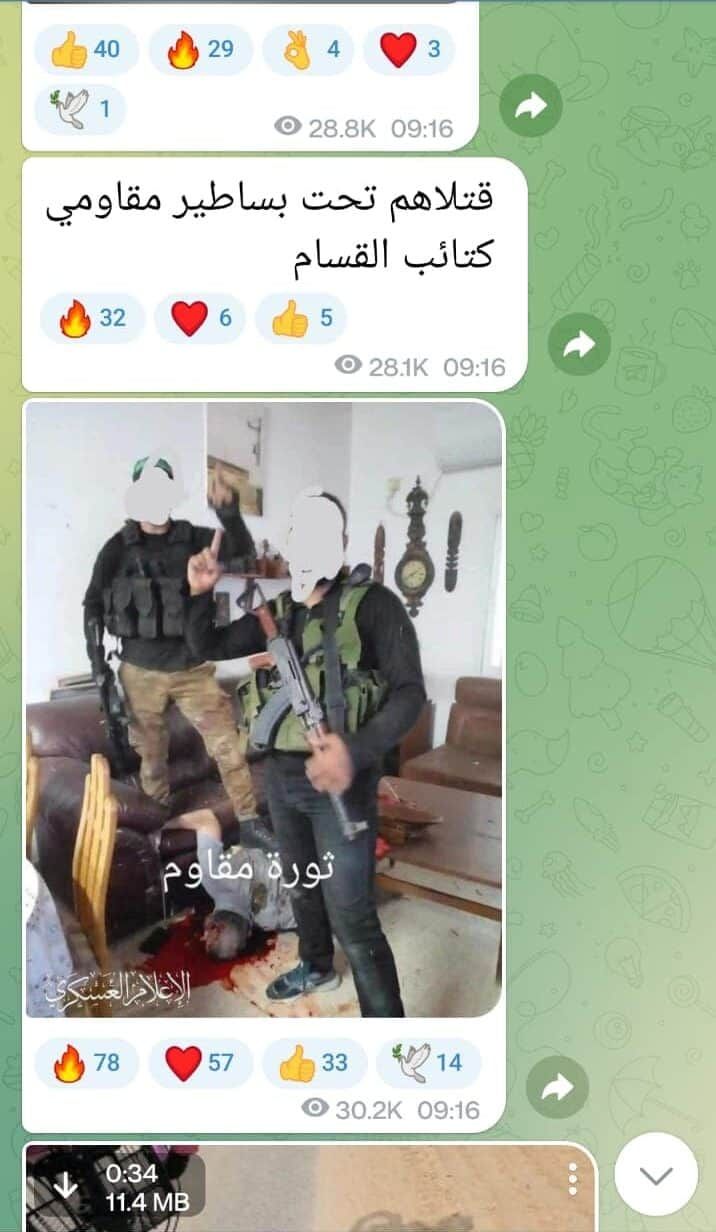
Yet The New York Times didn’t see any problem in dedicating an empathetic piece to Al-Najjar’s October 7 coverage (in the middle section of this news wrap). He was even interviewed to give a first-hand account:
Mr. Al-Najjar, a freelance reporter who posted the footage to social media, initially entered Israel through a breach in the fence along the perimeter with Gaza. He said it was the first time he had ever left Gaza in his life, because of the blockade imposed by Israel and backed by Egypt that restricts movement in and out of the enclave.
While women were raped, families tortured to death and children burnt alive, The New York Times still made sure to highlight how it was the first time Al-Najjar set foot — like the terrorists — on Israel’s territory. And the terrorists clearly let him do his job uninterrupted.
The piece also mentions Al-Najjar’s filming the kidnapping of a terrified mother and her two children and a video in which he seems to document himself taking a ride on a motorbike into the kibbutz where the abduction took place.
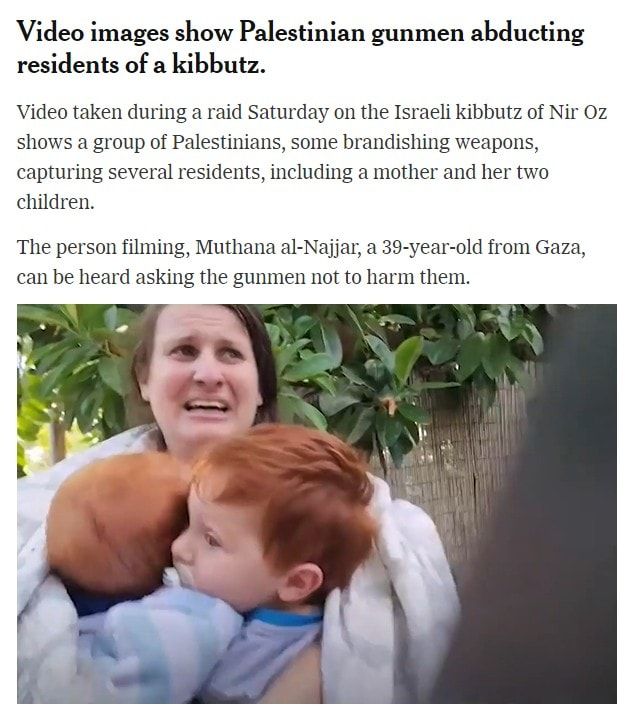
The author of the piece, Yousur Al-Hlou, attempts to humanize Al-Najjar by including sentences like: “The person filming, Muthana Al-Najjar, a 39-year-old from Gaza, can be heard asking the gunmen not to harm them.”
The piece shamefully ends with Al-Najjar’s quote concerning dead terrorists he had recognized, which makes it seem as if they were victims rather than perpetrators:
“Mr. Al-Najjar said that as he was leaving Nir Oz, he saw at least two gunmen whose faces he recognized lying dead in a field, and he thought there were likely others.
“There are dozens missing there, as well as dead and injured,” Mr. Al-Najjar said. “No one knows how many.”
It is worth noting that Al-Hlou is also the author of a piece published by The New York Times on November 9 featuring a video by none other than discredited photojournalist Hassan Eslaiah, who was exposed by HonestReporting a day earlier and whose acquaintance with Yahya Sinwar — the Hamas mastermind of the October 7 attacks — has been made public.

The piece presents the work of three Gazan self-proclaimed journalists (see below for further details on two of them). It does clarify they are not neutral observers. But it includes an Instagram video featuring one of them that — according to the Arabic watermark (circled in red in the screenshot above) — has been shot by Eslaiah. It seems like Eslaiah even interviewed the person he had filmed, although the question answered is edited out.
While one can only hope that Al-Hlou and her editors at The New York Times missed this tiny detail, they should have done a better job checking the source of what they wished to present to their audience. Especially considering CNN and AP announced within hours after the HonestReporting expose that they had cut ties with Eslaiah.
Related Reading: Broken Borders: AP & Reuters Pictures of Hamas Atrocities Raise Ethical Questions
Reuters, LA Times and NBC News Rely on Influencers Who Praised Hamas Attack
Furthermore, a joint investigation by The Jerusalem Post and HonestReporting has revealed the names of several Gazan social media influencers who have praised Hamas’ October 7th attack, and whose work is used, reported on, or relied upon by international media.
One of them is Doaa Rouqa, a freelance Reuters photojournalist, who has over 270k followers on Instagram. On October 7, she posted praise for Hamas’ attack on her Facebook page. One post reads in Arabic: “October, Gaza, Glorious — history will record. Alaqsa flood.” Another, showing a picture of Hamas terrorists inside Israel, reads: “May God protect them. #alAqsa Flood… A morning and day like no other on the road to liberation and great victory, God willing.”
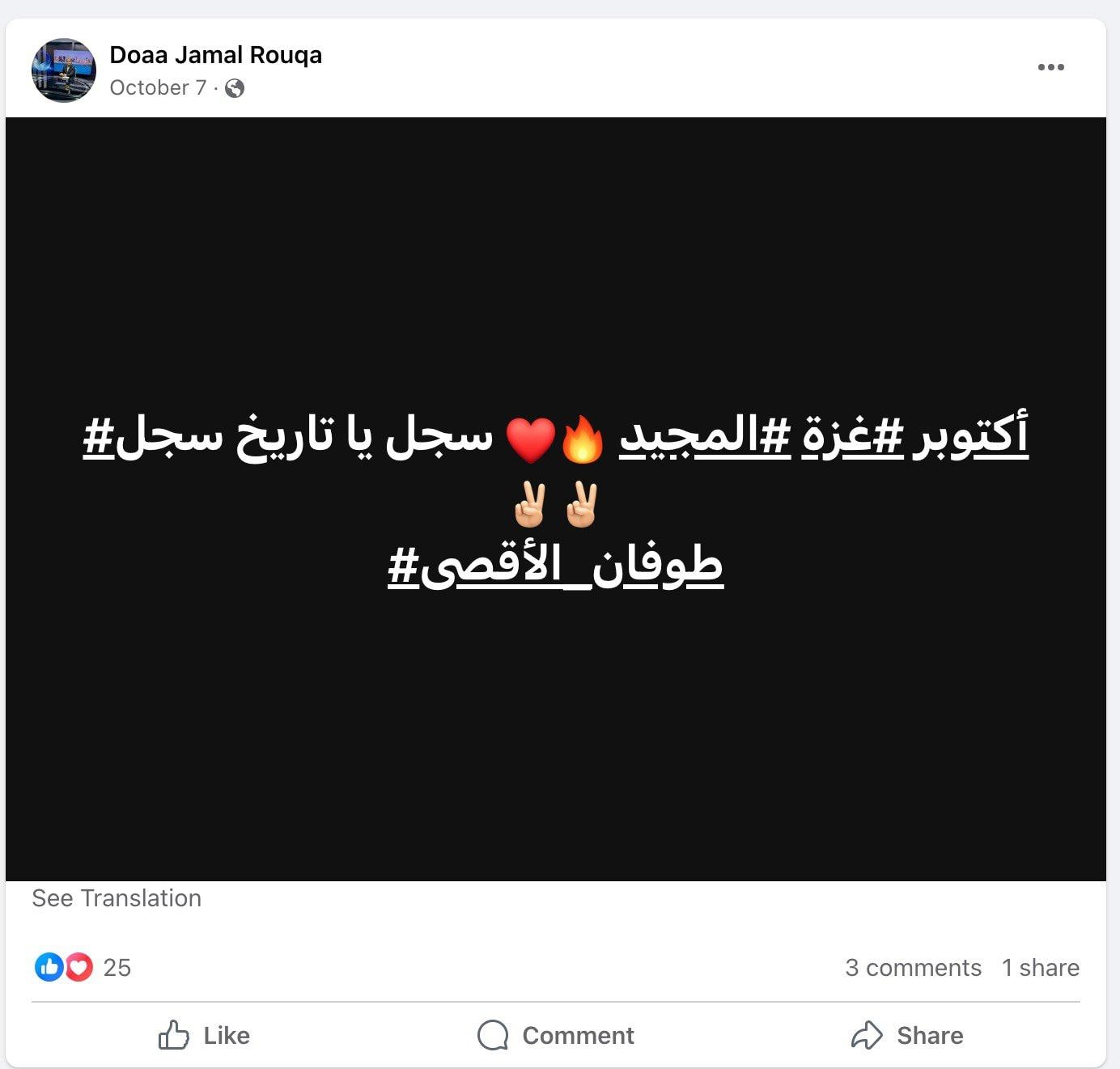

This overt support for terror did not prevent Reuters from buying her photos, which according to the news agency’s database, mainly feature Gazans suffering at Al-Shifa Hospital.
Did Reuters check Rouqa’s background or ask about her ability to deliver impartial coverage from where, according to the Israeli army, Hamas commanders are hiding?

Other outlets, like NBC News, have written about “the unfiltered coverage” of popular digital creators like Motaz Azaiza or Hind Khoudary:
The unfiltered coverage, as seen in the Instagram post below, adds a unique element to the broader journalistic efforts to capture what’s happening in Gaza.
But NBC News failed to mention that Khoudary is a Hamas collaborator who had turned Palestinians working for peace with Israelis over to Hamas. It also failed to mention that Azaiza had posted on social media platform X a video of the kidnapping of Israelis into Gaza. He also posted a video showing Hamas terrorists inside Israel with a triumphant caption reading in Arabic: “The Gazans entered the settlements!!!!!!!! With jeeps we see in the streets of Gaza.”
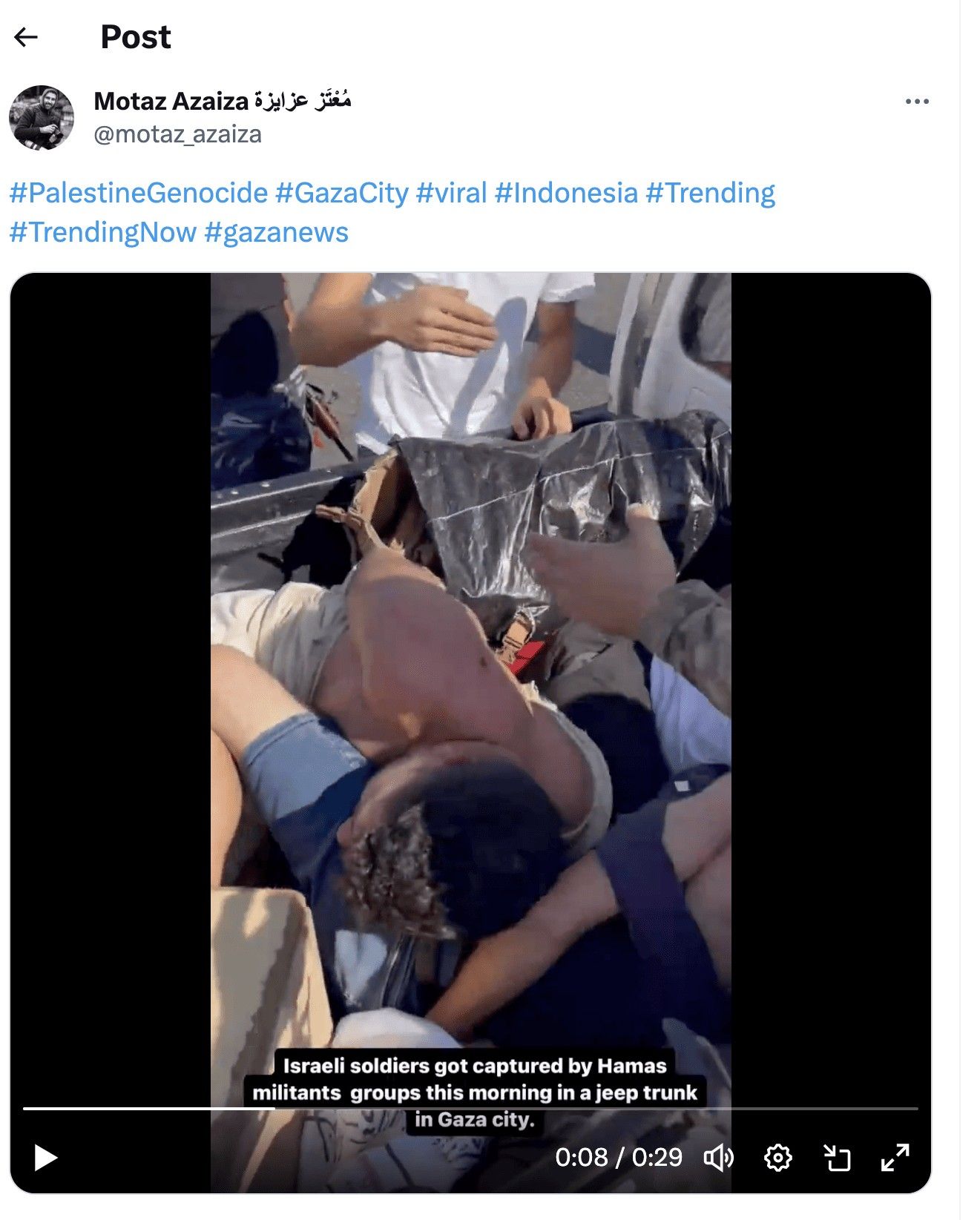
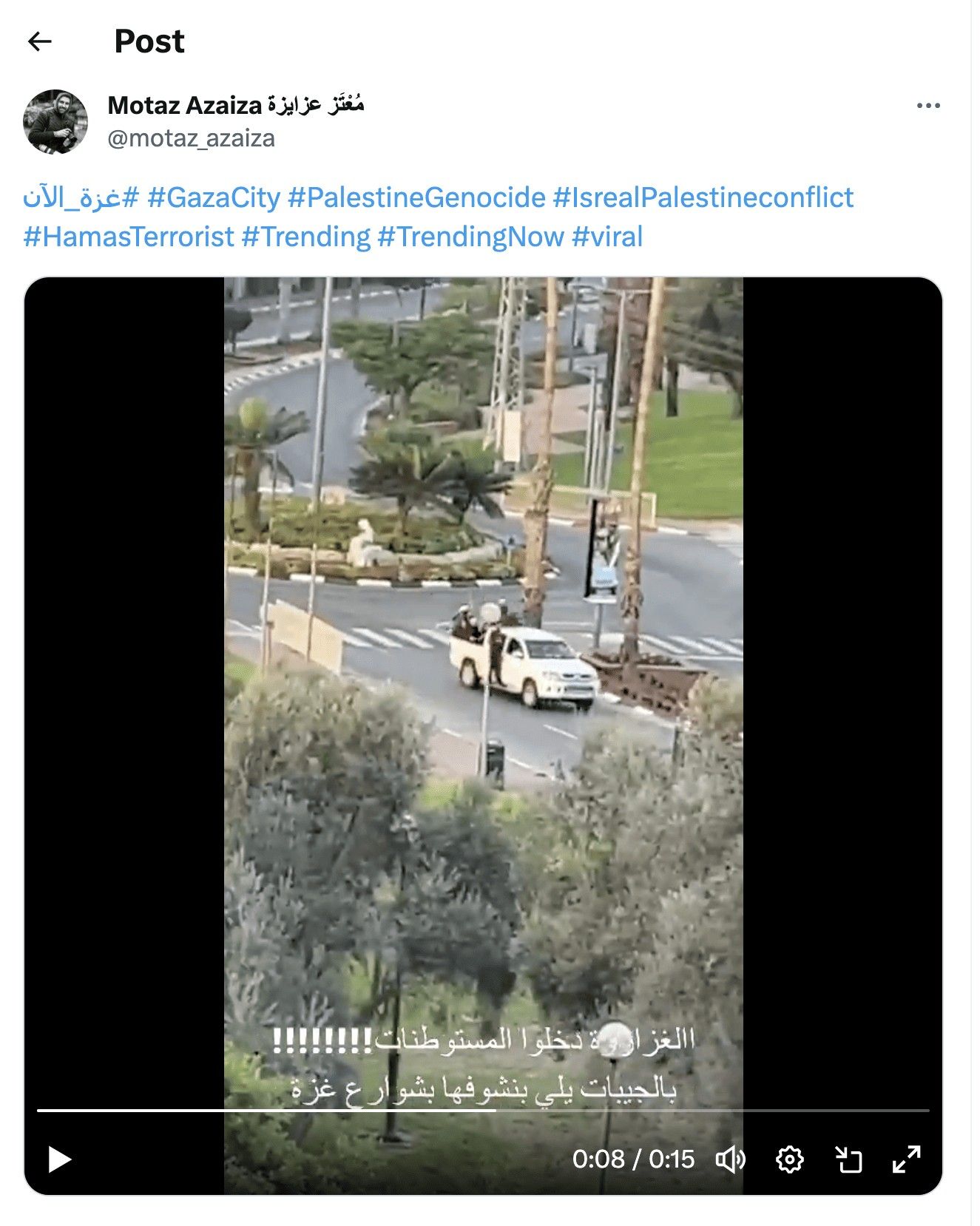
Related Reading: Washington Post, AP Interview Gaza ‘Journalist’ and Hamas Collaborator Who Snitched on Palestinian Peace Activists
The piece includes a video of Khoudary and Azaiza shot by another Gaza influencer with 2.4 million followers on Instagram, Ahmed Hijazee. On October 7, Hijazee posted on X the following praise for Hamas’ October 7 attack with a heart emoji and a Palestinian flag: “The men of the resistance are traveling inside our occupied territory.” He also posted a video showing the terrorists celebrating over the mutilated body of an Israeli soldier, with an emoji of a handshake and a comment saying in Arabic: “The talk is about kidnapping a soldier and bringing him to the center of Bani Shaila. He was presented in front of the people.”


Khoudary and Azaiza are also mentioned in a Los Angeles Times piece from October 29. The piece quotes them as unbiased witnesses who had bravely shared their experiences of a weekend blackout in Gaza. Nowhere does it mention Khoudary’s background or Azaiza’s uploads.
International media should not be a careless mouthpiece for pro-Hamas voices. They should not lend legitimacy or credibility to people who praise terrorism.
The least they can do is properly vet and question the Gazan journalists and social media influencers they give a platform to or rely upon, bearing in mind how the territory is run by a terrorist organization that controls the flow of information.
The audience has a right to know that these people are not neutral bystanders supplying objective materials and information. The media have a duty to exercise transparency.
Liked this article? Follow HonestReporting on Twitter, Facebook, Instagram and TikTok to see even more posts and videos debunking news bias and smears, as well as other content explaining what’s really going on in Israel and the region.
Photo credit: Edi Israel via Flash90

